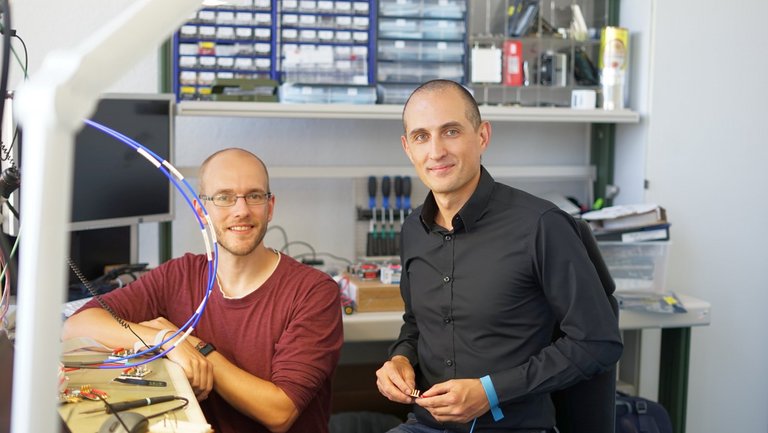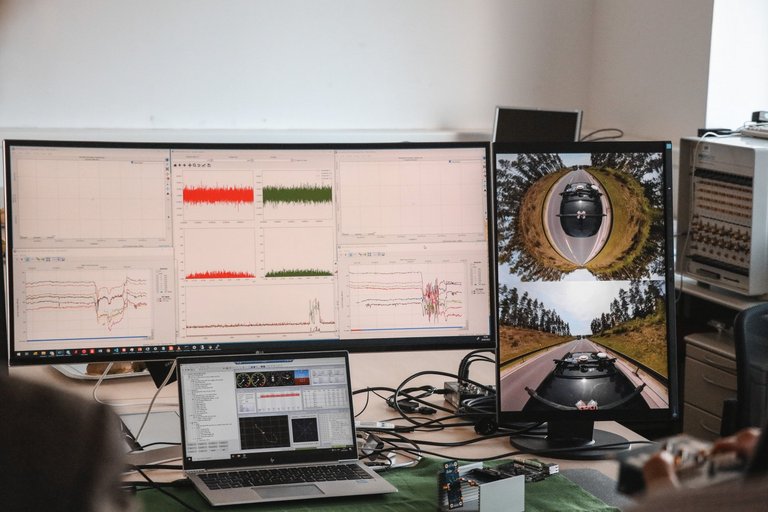Whether for autonomous driving, at airports, in the maritime sector or for drone flights - a TAB research group at the Fraunhofer Institute for Integrated Circuits IIS with the Electronic Measurement and Signal Processing EMS Group and the Group of the same name at TU Ilmenau would like to make signal transmission from navigation satellites such as GPS or Galileo less susceptible to interference. In the research project "HyLoC - Hybrid Low-Cost Multiantenna GNSS Receiver", the scientists have designed an energy-efficient and handy multichannel signal receiver that can be integrated into navigation systems and should soon be standard in car equipment.
Scientists develop interference-resistant and low-cost navigation receiver for autonomous driving
![[Translate to English:] [Translate to English:]](/unionline/fileadmin/_processed_/f/9/csm_Markus_Landmann_aed6983bb0.jpg)
"GPS signals are extremely susceptible to interference," says Christoph Wagner, research associate at the Electronic Measurement and Signal Processing Group and HyLoC project manager. Especially in road traffic, it becomes a problem for drivers when their navigation device suddenly cannot provide any information about the route. The reason for the susceptibility of these navigation systems to interference is the low power of the navigation signals from the satellite. By evaluating them at the GNSS receiver - short for Global Navigation Satellite System, which includes GPS, GLONASS, Galileo or Beidou - the navigation system is able to determine the exact position of the car. However, if there are different radio systems in the car, the smartphone, for example, can cause interference with this sensitive signal. Mobile and inexpensive jammers or spoofers are also frequently used to actively deceive navigation systems. However, since these affect the navigation systems of all vehicles in the immediate vicinity, they pose a particularly serious safety risk in autonomous road, air or ship traffic.
Interference suppression systems for the consumer market
To avoid interference like this, operators of critical infrastructure, such as airports or other authorities with sovereign tasks, resort to cost-intensive and sometimes very large interference suppression systems. These devices are equipped with up to six receive channels and can use them to amplify the signals of the various GNSS satellites depending on the direction as well as to specifically suppress unwanted interference signals by means of induced cancellation (interference). However, major disadvantages of the systems are their high complexity, high costs and high energy consumption. In the HyLoC project, scientists at Fraunhofer IIS in Ilmenau and TU Ilmenau have set themselves the goal of developing a handy variant of a multi-antenna receiver for the consumer market. In the future, the devices should be easy to integrate into any navigation device and become a standard part of a car's equipment, as Christoph Wagner says:
We want to build very small multichannel receivers that consume little energy and sufficiently suppress interferers. In this way, we solve the problem of signal interference, accessible to everyone, inexpensively and suitable for the mass market.

High safety with fully autonomous driving
After two and a half years of project work, the research group has succeeded in drastically reducing the size of a multichannel receiver while maintaining the same performance, so that the device now fits on the palm of a hand. In a laboratory, the scientists emulated a virtual noise environment and successfully tested the multichannel receiver in various application scenarios. In regular workshops, an industry advisory board consisting of MetraLabs GmbH, Mercedes-Benz AG, Robert Bosch GmbH, Funkwerk AG and EPAK GmbH supported the research group in charting a course that was as close to the application and as relevant to industry as possible.
In follow-up projects, the scientists plan to further develop the multichannel receiver and integrate it into chips that will be incorporated into commercially available GNSS receivers. Finally, a demonstrator is to prove the effectiveness of the device in practical tests. Dr. Markus Landmann, HyLoC project coordinator at Fraunhofer IIS and head of the EMS department, sees great potential for the product developed in Ilmenau for a wide range of applications, for example in shipping or for flying drones, which are also to be used to deliver packages, but especially for autonomous driving:
Fully automated driving places extremely high safety requirements on GNSS receivers. A vehicle's position must be determined reliably and precisely for Level 5 autonomous driving, and interfering signals endanger traffic. With our research, we want to contribute to safe and smooth autonomous driving.
The research group HyLoC was funded by the Free State of Thuringia with money from the European Social Fund under the identifier 2019 FGR 0100.

Contact
Dr. Markus Landmann
Head of the Electronic Measurement and Signal Processing Group at Fraunhofer IIS



